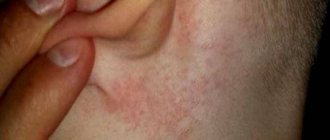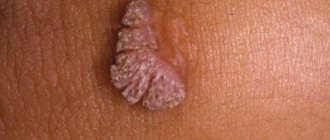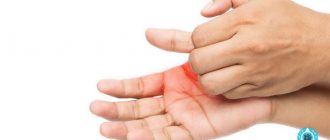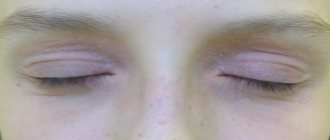You can often tell from a person's face whether he or she has health problems. In this regard, it is very important to follow simple rules and lead a healthy lifestyle to keep your face beautiful and young. However, there are also various kinds of manifestations of pathological changes that are almost impossible to avoid.
Not all people understand what can be done when the skin in the eye area becomes red and begins to peel. In this case, it is very important to understand the root cause of the disease. Below we discuss the main causes of such changes in the skin around the eyes, as well as recommendations for eliminating them.
Why does blepharitis occur?
Blepharitis can develop for many reasons. Among the main factors, doctors identify:
- viral infection;
- failure to comply with hygiene rules;
- demodicosis (Demodex mites);
- significant deterioration of immunity;
- the presence of other diseases of the organs of vision;
- presence of allergic diseases;
- chronic conjunctivitis and other inflammatory processes;
- constant exposure to irritating and damaging factors (dust, smoke, sand, dry air).
Why does the skin of the eyelids peel and itch?
Unpleasant symptoms can be caused by a variety of reasons: from general fatigue and stress to fungal infections and parasites. Common causes of peeling, itching, and swelling of the eyelids are:
- regular disturbances in the functioning of the body;
- allergic reactions;
- fungal infections, parasites;
- infectious or inflammatory eye diseases;
- dry skin, eye fatigue.
Diseases that differ in severity and severity at the initial stage are manifested by almost the same symptoms: peeling of the eyelids, swelling; itching, profuse discharge from the eyes; redness of the eyelids and eyeball. Therefore, it is important to understand what problems in the body are indicated by flaky eyelids.
How to recognize blepharitis?
There are common symptoms of blepharitis. These include:
- photophobia;
- rapid eye fatigue when reading;
- feeling of heavy eyelids;
- swelling, redness (especially in the morning after waking up);
- thickening and swelling of the ciliary edge of the eyelids;
- feeling of “sand in the eyes”;
- itching;
- eyelash loss;
- the appearance of discharge and gluing of the eyelids;
- the appearance of dry crusts on the ciliary edge of the eyelids.
If one or more of these signs appears, you should contact an ophthalmologist to make an accurate diagnosis and prescribe the most effective treatment.
Itching in the corners of the eyes
In ophthalmology, even such a symptom as the desire to constantly scratch the eyelids cannot be ignored.
If your eyes itch rarely, this is an accident, but if this condition turns into constant, persistent itching, this indicates the development of diseases.
Ophthalmologists talk about eye itching as a sign of pathology only if there are accompanying symptoms:
- profuse lacrimation,
- swelling,
- the presence of purulent discharge,
- redness.
What types of blepharitis are there?
Based on clinical manifestations, experts distinguish several types of the disease:
- Simple. With this form of blepharitis, the eyelids thicken, a large amount of white-gray secretion accumulates in the corners of the eyes, and the ducts of the meibomian glands are dilated.
- Scaly. On the edge of the eyelids of a patient suffering from this form of the disease, scales similar to dandruff accumulate - parts of the epidermis that stick to the base of the eyelashes.
- Ulcerative. With ulcerative blepharitis, ulcers are formed on the edge of the eyelids, covered with yellow crusts. In the advanced form, after the ulcers heal, scars form that disrupt the growth of eyelashes.
- Rosacea. This form of blepharitis is characterized by the formation of red-gray nodules on the skin, often with ulcers.
- Demodectic. Blepharitis caused by mites of the genus Demodex occurs with unbearable itching, the release of a sticky secretion that dries on the eyelids, redness and thickening of the edges of the eyelids.
- Allergic. Blepharitis of this type is in all cases associated with exposure to an external factor – an allergen. With this form, the eyelids thicken, the skin darkens, there is pain in the eyes, photophobia, lacrimation, and mucous discharge may appear.
Influence of the external environment
People with inherently dry skin are susceptible to environmental factors. For example, in winter, in the wind, the delicate skin around the eyes very quickly begins to peel off. This happens due to the fact that the thickness of the skin in this area is very small. In this case, a moisturizing and nourishing cream will help cope with the cosmetic defect, which is used not only at night, but also under makeup before going outside. In this case, all layers of the skin will receive a sufficient amount of nutrients. The cream film also creates an additional protective barrier that will help prevent the negative impact of aggressive weather conditions on the delicate skin around the eyes.
How is blepharitis treated?
If signs of blepharitis are detected, the eye doctor will select the optimal treatment regimen for you. Most likely, it will include a complex of both local and general measures that affect the condition of the body as a whole. Treatment will depend on the causes of blepharitis, severity and neglect. As a rule, it includes:
- cleansing the eyelids from crusts, scales, purulent discharge (eyelid hygiene);
- applying antibacterial ointments;
- the use of special eye drops with an antibiotic and antiseptic;
- the use of natural tear substitutes.
In some cases (with demodectic blepharitis), antiparasitic drugs are also used.
Peeling under the eyes
Our face is a clear indicator of our lifestyle and existing ailments; it reflects almost all problems of the body. Therefore, it is very important to monitor your health, then your face will remain young and beautiful longer. But even the healthiest people experience a variety of visual manifestations of diseases, which cannot always be avoided.
What, for example, should you do when the skin under your eyes starts to turn red and peel? The most important thing is to find the reason. Actually, there are not so many reasons for this phenomenon. We will try to consider the main ones and find out methods for eliminating them.
Surely, people with dry skin will now remember themselves. Imagine coming home on a snowy winter day, when there is frost and wind outside, and you discover that the skin under your eyes has tightened and it has begun to peel. This happened due to the special thinness of the skin in this area, which, reacting to weather conditions, simply dried out quickly. Getting rid of this phenomenon is quite simple. It is necessary to lubricate problem areas with a soft nourishing cream. Be sure to apply it under your eyes before using makeup and only then feel free to go outside even in the bitterest frost. The skin will receive the necessary nutrients, and the cream base will create an additional barrier that prevents the action of an aggressive environment.
Allergies are one of the most common causes of flaking around the eyes. Especially if atopic dermatitis is diagnosed. It manifests itself as redness of the skin, peeling of its top layer, and periodic itching. This manifestation is very unpleasant, but in the chronic form of the disease it is absolutely inevitable. What to do in this case?
You need to know that atopic dermatitis is cyclical and appears periodically, at a certain time. Usually this is the spring and autumn period - the off-season. Therefore, for this period it is worth stocking up on antihistamines, coupled with special ointments that will relieve symptoms. As a rule, they use Lorizan gel, Allergozan and Sudocrem ointments (it is considered a baby cream and is great for minor skin problems, its consistency is very thick, with the necessary nutrients). In addition, you can use “Bepanten” - a cream with panthenol, a substance that quickly heals wounds on the skin and promotes its regeneration.
Before using any of the drugs, be sure to read the instructions carefully. But it’s better to consult a specialist, because you need to get rid of atopic dermatitis, and for this you need to know the cause of its occurrence.
The causes of this disease are very diverse. These are especially common:
- Insect bites;
- Food allergies;
- Reaction to flowering plants and their pollen.
Atopic dermatitis can affect any area of the skin of the face, but especially often the lesions are localized under the eyes, as well as around them, because the skin here is the thinnest and most sensitive. It is worth remembering that the success of treating peeling under the eyes mainly depends on the treatment of allergies, as well as the elimination of the factors that caused them.
It is necessary to mention that in women, redness, as well as peeling of the skin under the eyes, is often a one-time reaction that can occur to a certain brand of cosmetics. It is worth paying close attention to which lotion or foundation does not suit your skin. To be on the safe side, when purchasing, choose products labeled “for sensitive skin.” It has a more gentle composition and is easier to tolerate. While heavy creams and decorative cosmetics can cause very strong irritation.
If you are sure that the reaction that has occurred is caused by a cosmetic product, you should do a few simple manipulations. 1. Completely remove the cosmetic product. Moreover, this needs to be done not only with a special product (milk or tonic), but also with running water. In this case, you should not use soap, so as not to irritate the skin even more.
2. Make soothing lotions with healing infusions (chamomile, string) or use a healing cream with natural extracts. At the same time, any products must be proven and well tolerated by the skin. When there is no negative reaction to panthenol, you should use this remedy. True, it must be applied very carefully, making sure that it does not get on the mucous membranes. It is necessary to remember that after using the decoction, you will also need a nourishing cream. If it is difficult to choose the right one, you should buy a regular baby cream for babies in the first days of life. Its action is particularly gentle and does no harm at all, and relieves inflammation well.
3. Eliminate the use of the cosmetic product that caused the reaction and look for a replacement. In this case, the application of the alternative option should take place at least one day after the complete disappearance of the inflammatory reaction under the eyes.
So, as a conclusion, let us once again summarize the causes of redness and peeling under the eyes:
- Physiological skin type (it is too dry and any atmospheric influences can lead to an undesirable reaction);
- Allergic manifestations (there are many forms of allergies, as well as allergens, however, allergies are often hereditary in nature, so it is initially necessary to perform an allergy test, find out the allergen and try to avoid its exposure. Take antihistamines, use special ointments);
- Single reaction to cosmetics.
In the medical department, everyone can undergo examination using the most modern diagnostic equipment, and based on the results, receive advice from a highly qualified specialist. The clinic is open seven days a week and operates daily from 9 a.m. to 9 p.m. Our specialists will help identify the cause of vision loss and provide competent treatment for identified pathologies.
You can make an appointment at the Moscow Eye Clinic by calling 8 8 (499) 322-36-36 (daily from 9:00 to 21:00) or using the online registration form.
What eye diseases cause redness of the eyelid skin?
Infectious eye diseases
Among infectious eye diseases that cause severe itching, barley is the leader. Very often, such symptoms are harbingers of barley. As a rule, after 2-3 days a slight swelling appears at the site of irritation. Barley can be easily treated if you consult a doctor in time. You should not self-medicate, as this can lead to complications.
A proven way to treat the problem is dry warm compresses. To warm the barley, boiled eggs, potatoes, heated flax seeds and wrapped in a napkin, and salt are used.
Often the cause of the above symptoms is fungal conjunctivitis. You can get this disease from animals, other people, plants or contaminated water. It is important that with fungal conjunctivitis, only the lower or upper eyelid is initially affected; it turns red, peels, and is very itchy.
Eyes can itch with the flu or a common ARVI; many viral infections begin with itching in the eyes, then other symptoms appear.
Chronic eye infections indicate two things. First, a person’s immune system is weakened. Secondly, a person neglects hygiene, scratches or rubs his eyes with dirty hands.
Symptoms of seborrheic dermatitis
The main reason for the development of seborrheic dermatitis is the intensive proliferation of the fungus of the genus Malassezia furfur in seborrheic areas. This fungus is present on the skin of most people, that is, it exists in symbiosis with it. However, it does not cause the development of seborrheic dermatitis in all people. Only in the presence of provoking factors does the proliferation of the fungus get out of control, which leads to the development of the disease.
Most often, the symptoms of seborrheic dermatitis are localized on the face or scalp. The classic manifestation of the pathology is symmetrical damage to the border of hair growth, eyebrows, and eyelashes. The area behind the ear, chin, and mustache area may also be affected. If seborrheic dermatitis is localized on the body, then the chest area, groin area, and armpits are susceptible to rashes.
Symptoms of seborrheic dermatitis are:
- skin irritation and redness;
- peeling of the eyelids;
- scales;
- rash;
- acne;
- hair loss.
What to do if the skin of the eyelids is very itchy and itchy
If your eyelids become red, swollen, or itchy, you can try to determine the causes of the diseases causing such symptoms yourself, but treatment must be prescribed by a doctor. You should start taking any medications only on the recommendation of a doctor. A large number of eye diseases take a long time to be treated, sometimes it is necessary to change the course of treatment.
Each of them requires an individual approach, taking into account the individual characteristics of the body, which can only be identified by a qualified specialist. The drugs prescribed by the doctor do not just eliminate the cause of the disease, they relieve its manifestations.
It is important to adhere to basic hygiene rules; be attentive to the choice of hygiene and cosmetic products; Follow the daily routine and rules for working at the computer. Often, such symptoms go away on their own after a short time, if you give the body rest and the opportunity to recover.
But when they are observed for several days, it is necessary to visit a doctor. Start with a therapist who will write a referral to a specialist - an ophthalmologist, dermatologist, allergist.
Natural remedies for peeling eyelids
- Oatmeal, previously steamed in hot milk, has an excellent softening effect. Cool the mixture, add a little butter to it until it has a creamy consistency. Apply to the eyelid for half an hour several times a day.
- Inflamed upper eyelids can be treated with applications of grated carrots and bananas. Boiled potatoes are very effective. You can apply bread softened in milk to the affected areas daily. After just a couple of days of this treatment, the itching will become much less, and the peeling will begin to subside.
- Lotions help a lot. Ingredients: lily of the valley flowers, leaves - a teaspoon; water - glass. Pour boiling water over lily of the valley, leave for 30 minutes, strain. Moisten cotton swabs with infusion, place on eyelids, hold for 20 minutes. Apply for two weeks morning and evening.
- At first, the main thing is to soften the inflamed skin. Various masks with olive oil are perfect for this. It's better to make them at night. Almond oil is also useful, as it relieves irritation and perfectly nourishes the skin of the eyelids.
- However, if peeling of the eyelids is caused by demodicosis, then it is better to avoid masks with oils. First of all, you need to disinfect the affected skin. Tar soap will help in the fight against demodicosis. You should wash your face with soap every day. It should be noted that this cosmetic product does not have a very pleasant smell, but its effect is wonderful.
- The following home remedies effectively fight eyelash mites: compresses made from a decoction of buckthorn, linden, and juniper; washing with a decoction of oak bark and compresses with fresh cabbage juice; alternate use of cold and hot compress with chamomile decoction.
No matter how varied the folk recipes are that help eliminate peeling skin on the eyelids, remember that a visit to a specialist should come first.
Treatment of blepharitis
In case of an allergic form of the disease, complete exclusion of the identified allergen is recommended. Recommendations may also include, depending on the type of blepharitis:
- applying eye cream;
- special shampoo for seborrheic form;
- eyelid massage;
- strengthening the immune system;
- external treatment of eyelids and/or eyelashes;
- use of ointments;
- antimicrobial eye drops;
- diet adjustments;
- physiotherapy (electrophoresis, UHF, magnetic therapy, ultraviolet treatment, darsonval);
- removal of ulcer crusts in peptic ulcer disease.
If you delay treatment, ignore the doctor’s recommendations, or self-medicate, this can cost your baby his sight and also lead to other unpleasant consequences.
Care and prevention
Most eye problems, including pathological itching, can be avoided by following preventive instructions:
- maintain personal hygiene;
- protect your eyes from prolonged exposure to the sun using sun protection optics;
- when working at the computer for a long time, take an hourly break from the monitor to perform eye exercises;
- Avoid contact with allergens if the problem is allergic eye reactions.
But the most important thing is not to ignore any suspicious, even painless, symptoms.
You have found a red spot on your child’s eye – should you worry and what should you do?
The child’s blood vessels, including those piercing the eyes, are characterized by increased fragility.
As a result of this, any injury, overexertion or loud scream can provoke their rupture.
In this case, a red spot appears on the mucous membrane of the eye, which causes a lot of concern among parents.
Regardless of the symptoms, if the redness does not go away for a long time or the child complains of severe discomfort, you should immediately visit an ophthalmologist.
A red spot is formed if the capillaries rupture, and blood leaks to the surface of the mucosa through the conjunctiva.
- various injuries, for example, received during games;
- infectious diseases;
- eye strain. It is especially common among schoolchildren and students who spend a long time studying;
- lack of sleep. Typical for teenagers, for example, during preparation for exams or disruption of the daily routine;
- severe cough. This cough can occur during infectious diseases;
- cry. Often, while crying, children rub their eyes with their hands, which results in the rupture of small blood vessels and the formation of red dots;
- external influences. A similar problem can arise against the background of negative external influences, for example, sudden temperature changes or strong winds;
- overvoltage. Children, just like adults, can have intestinal problems. During severe constipation, excessive tension and rupture of capillaries occurs.
However, parents should be aware of possible side complications and ask the doctor to cancel such treatment.
You should seek help immediately if your child experiences the following symptoms:
- severe pain that prevents you from fully opening and closing your eyes;
- increase in spot;
- hearing, speech or coordination problems.
If the patient complains of a headache or has problems with coordination due to the formation of a red spot, this may indicate the presence of a traumatic brain injury.
Most often, therapy consists of using special drops to soothe the mucous membrane and accelerate the regeneration of damaged tissue.
If redness occurs due to an injury to the eye or head, the baby requires hospitalization.
Prevention
performing special exercises. Eye gymnastics allows you to relieve excess tension and feelings of fatigue
In addition, regular exercise helps strengthen muscles and blood vessels. Gymnastics is especially useful for students and schoolchildren; normalization of the daily routine. It is important to ensure that the child goes to bed and gets up on time; reduce the time spent in front of a computer or tablet monitor; monitor the air humidity in the room. If there is excessive dryness, it is recommended to place a humidifier in the nursery; normalize nutrition. The child’s diet should include fresh fruits, vegetables, meat, as well as a number of products that help strengthen the walls of blood vessels; strengthen the immune system. In the autumn-winter season, it is important to give your child multivitamin complexes. Preference can be given to complexes aimed at eye health; observe safety precautions. When performing some work involving small parts, it is important to teach your child to use eye protection.
In most cases, the formation of a red spot in a child’s eye is associated with mechanical injuries, for example, received during play.
Parents should be wary of two things:
- if the stain does not go away for a long time or becomes larger;
- if the child suffers from accompanying symptoms, especially those related to speech or coordination disorders.
In most cases, the formation of a red spot in a child’s eye is associated with mechanical injuries and requires referral to specialists.
In some cases, redness of the eyelids is not a consequence of serious illnesses, so parents do not need to worry
However, it is important to remember that the cause of the phenomenon can only be determined by a qualified pediatrician.
Thin skin through which blood vessels are visible is considered normal for infants. Over time, such a flaw will disappear. There is no need to worry if the redness is not accompanied by peeling, itching, or an increase in basal temperature.
Insect bites can also cause swelling. In such situations, special gels will come to the aid of parents, the use of which is approved for children from the first months of life.









